There are 20 species of turtles in New York state. Not all of these are native species as there are three non-native invaders that are colonizing the Empire State. The Northern Redbelly Cooter, Red Eared Sliders, and Yellow Belly Sliders have arrived by human hands and set up populations across the state.
On top of these 15 turtles living in the state, there are 5 species of Sea turtles that can occasionally be seen off the coast. So far, there is no proof of alligators or mutated ninja turtles living in New York’s sewers.
This list can be used as both a field herping guide and a reference list for anyone looking to choose one of New York’s turtles as their next pet. Keep in mind that within New York state itself, every single native species aside from Common Snapping turtles are protected and cannot be owned, sold, or taken from the wild.
But, the Common Snapping turtle is the official reptile of New York, so do you really want to take this regal turtle from its home? I didn’t think so.
If you can, try and adopt a turtle from an animal shelter or reptile rescue first. If that isn’t an option look for captive-bred specimens from licensed and registered breeders. You don’t want to accidentally support the people taking wild turtles and selling them. It causes all kinds of problems.
Now, without further ado, let’s dive into the 20 species of turtles in New York state.
Table of Contents
Turtles in New York State
1. Blanding’s Turtle

- Experience Level: Intermediate
- Family: Emydidae
- Scientific Name: Emydoidea blandingii
- Other Names: N/A
- Adult Size: 5 to 8 inches (12.5 to 20 cm)
- Life Span: Up to 80 years
- Average Price Range: $300 to $450
- Conservation Status: Endangered
Named after 19th-century naturalist William Blanding, these beautiful turtles are not only threatened in New York but endangered across the nation. Habitat destruction is the main culprit.
Blanding’s turtles live in wetlands, bogs, sedge meadows, marshes, and small streams. They need very clean water and a plethora of vegetation. When these areas disappear, these turtles have nowhere to live, feed, and hibernate.
These turtles have dark, nearly black oval shells covered in pale yellow speckles. Their plastrons (bottom section of their shell) are yellow with black patches. On their long necks and under their chin, you’ll see bright yellow.
It may be difficult to see them in their natural habitat because they are very cautious. At the first sign of trouble, Blanding’s turtles will often dive to safety.
Blanding’s turtles are omnivorous but they tend to mostly eat crustaceans, insects, and mollusks. Occasionally they will feed on plants.
2. Bog Turtle
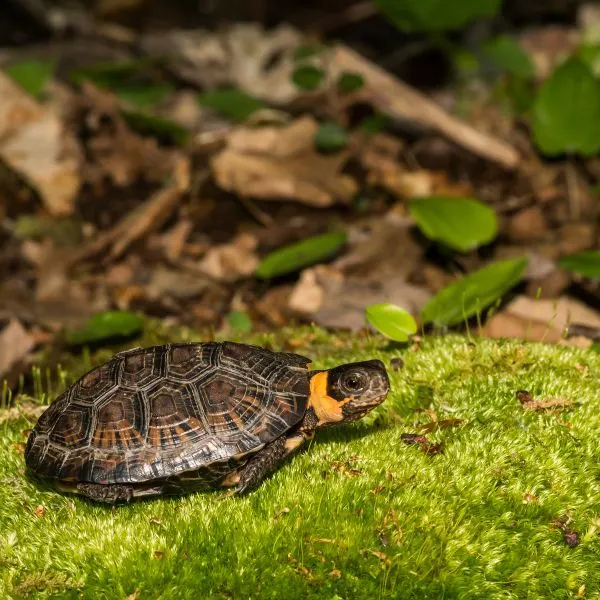
- Experience Level: *Expert
- Family: Emydidae
- Scientific Name: Glyptemys muhlenbergii
- Other Names: Muhlenberg’s turtle
- Adult Size: 3.5 to 5 inches (9 to 12.5 cm)
- Life Span: Up to 60 years in the wild
- Average Price Range: Illegal to own, Federally protected species
- Conservation Status: Critically endangered
Bog turtles are both the smallest turtle species, and one of the most Critically Endangered in North America. They are found in a few southern and central counties in New York, and a few other northern states.
They inhabit swamps, bogs, marshes, and other wetlands. If you see these turtles in the wild, be careful about posting on social media. When sharing the pictures, if it has a geolocation tag, poachers can locate the region and eliminate entire populations.
Not only are poachers a problem but habitat draining and destruction as well as increased predation. Raccoon populations are on the rise and they will quickly eat small turtles such as the tiny Bog turtle.
These turtles are particularly cute. Aside from their tiny stature, they have a midline keel that fades with age. The carapace is dark brown and ridged and may have starburst patterns on the scutes, while the plastron is black with some degree of tan or orange.
The skin and scales are dark brown or black, and they have bright orange patches behind the eyes that may connect, producing a ring of color.
Bog turtles are omnivores and mainly eat insects and mollusks along with occasional pieces of vegetation.
Box Turtles in New York
3. Eastern Box Turtle

- Experience Level: Beginner
- Family: Emydidae
- Scientific Name: Terrapene carolina carolina
- Other Names: Land Turtle
- Adult Size: 4 to 7 inches
- Life Span: 50 to 100 years
- Average Price Range: $260 – $360
- Conservation Status: Michigan, New Hampshire, Massachusetts, and Connecticut—list the animal as a species of special concern, and Maine lists the turtle as endangered.
New York’s only terrestrial turtle, the Eastern Box turtle wanders around in forests, thickets, and occasionally grasslands. They need a high humidity environment and will stay near a water source such as ponds and shallow streams.
Eastern Box turtles have a high-domed, hinged shell that can close up tightly. The carapace is dark brown with various yellow, orange, or red patterns. The plastron is tan with shades of brown or black.
Their skin and scales mimic their carapace colors. You can sometimes tell the gender by looking into their eyes. Males have red eyes, while females have yellow to brown eyes.
While these turtles roam quite a distance each day searching for food such as fungi, berries, worms, insects, and even carrion, they always stay within a few hundred yards of where they were born.
Terrapins in New York
4. Northern Diamondback Terrapin
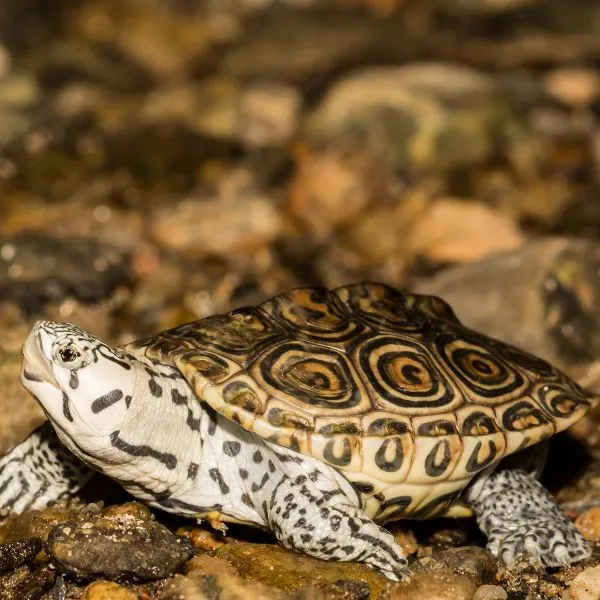
- Experience Level: Beginner to Intermediate
- Family: Emydidae
- Scientific Name: Malaclemys terrapin terrapin
- Other Names: Diamond-backed terrapin
- Adult Size: 4.5 to 9 inches (11.5 to 23 cm)
- Life Span: 25 to 40 years
- Average Price Range: $250 to $600
- Conservation Status: Special concern in Connecticut
If you see medium sized turtles swimming in brackish tidal marshes and estuaries in southeastern regions of New York and Long Island, chances are you’re seeing the Diamondback Terrapin. Upon further study, you may notice that the carapace is somewhat diamond shaped.
The upper shell can be grey, brown, or even black with distinct, dark rings on the scutes. Their skin is grey, possibly white, and may have a few patches of yellow, but it’s patterned with black speckles.
These are the only turtles in the United States that spend their entire life in brackish waters. They can stand full salt water for certain periods but they always return to their original homes. Some turtles such as the Common Snapping turtle can withstand brackish water for a time, but they can’t stay there full time.
Northern Diamondback Terrapins feed mostly on crustaceans, and crabs are their favorite foods. Because of this, many get trapped in crab pots and drown. Fishermen are supposed to have escape hatches for these turtles.
Other foods include mollusks, clams, winkles, shrimp, insects, and some vegetation.
Map Turtles in New York
5. Northern Map Turtle
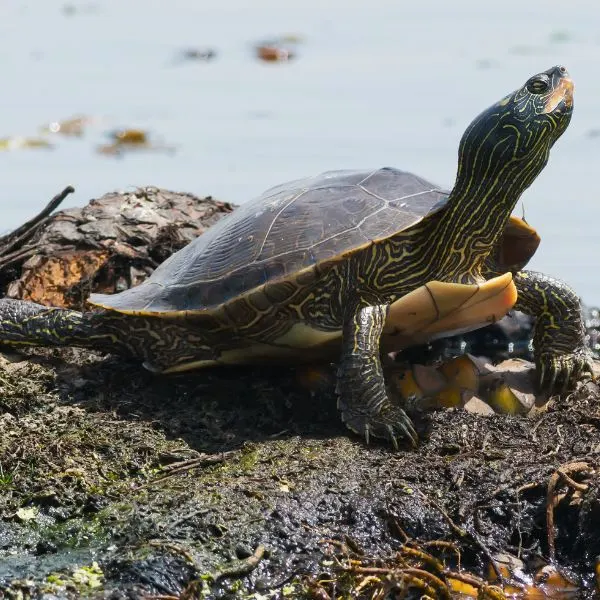
- Experience Level: Beginner
- Family: Emydidae
- Scientific Name: Graptemys geographica
- Other Name: Common map turtle
- Adult Size: Between 4 and 10 ½ inches
- Life Span: 15 to 20 years
- Average price range: Between $20 and $60
- Conservation Status: Least concern
Northern Map turtles are found in swift moving rivers, lakes, and streams. They spend most of their lives in the water or sunning on logs or river banks. They rarely leave the safety of the water. Even when basking this turtle always has an eye out for disturbances, when something unfamiliar gets within sight, they dive back into the water.
Map turtles have green or olive shells with a ridge. The back end is serrated and flared out. As the turtles get older these distinctions smooth out but don’t disappear completely.
The carapace has yellowish lines tracing across the shell, much like the contours of a relief map, hence their name. Their skin is olive to dark brown and has plenty of yellow or white stripes all over. Each species has a different, identifying set of markings on their heads, the Northern Map turtle has a pair of spots behind the eyes.
These turtles are mainly carnivorous and feed on crustaceans, mollusks, fish, and insects. They have been observed occasionally eating aquatic vegetation.
Mud Turtles in New York
6. Eastern Mud Turtle

- Experience Level: Beginner
- Family: Kinosternidae
- Scientific Name: Kinosternon subrubrum
- Other Names: Common mud turtle
- Adult Size: 3 to 4 inches
- Life Span: 40 to 50 years
- Average Price Range: $20 – $100
- Conservation Status: Least concern
Eastern Mud turtles are small aquatic turtles found in a few isolated populations on Long Island and the areas surrounding New York City. They inhabit shallow, slow-moving but clear waters such as bogs or swamps.
Eastern Mud turtles have smooth, oval-shaped carapaces that have a gradual slope at the front but drop quite sharply at the sides and back and range from brown to green to yellowish in color. They have large plastrons for their size, which are usually brown to yellowish-brown. They have mottled dark patterns on their grayish throats.
This species of Mud turtle is omnivorous and mainly eats small fish and mollusks but will also sometimes consume plant material.
Musk Turtles in New York
7. Eastern Musk Turtle
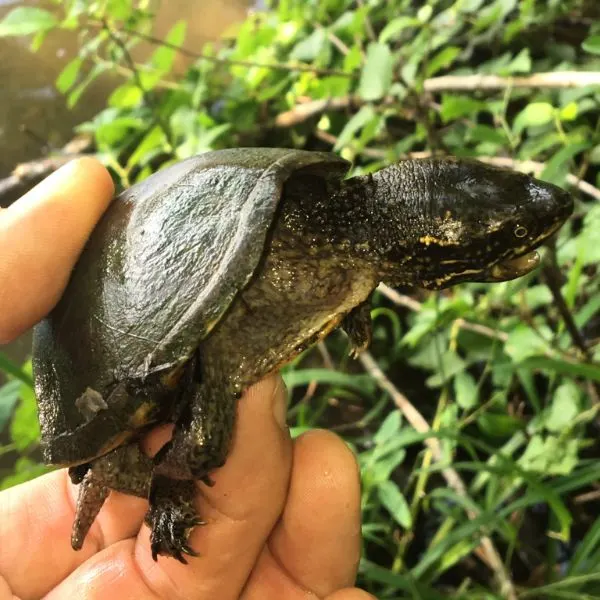
- Experience Level: Intermediate
- Family: Kinosternidae
- Scientific Name: Sternotherus odoratus
- Other Names: Common Musk turtle, Stinkpot
- Adult Size: 4 to 5 inches (10 to 12.5 cm)
- Life Span: 30 to 50 years
- Average Price Range: $30 to $120
- Conservation Status: Least concern
Eastern Musk turtles are a small, mostly nocturnal, aquatic species that are also known as “Stinkpots.” They have a pair of musk glands near their hind legs that can unleash a powerful stench when they feel threatened.
Along with chemical warfare, these turtles will try to bite when handled. Don’t be surprised or blame us when you pick up one of these little stinkers and it squirts you with a gagging, nasal clogging odor, and it chomps on your finger…you were warned.
Eastern Musk turtles prefer aquatic habitats with still waters and soft, sandy, silty, or muddy substrates. They don’t swim very well although they are very aquatic. Instead, they climb among the vegetation and run along the bottom to get around.
You’ll recognize these little turtles by the domed shell with flattened tops, and high sides and back. The carapace is solid brown, black, or olive colored, and often covered in mud. Their skin is also dark, but they have a pair of white or yellow stripes on their head and neck.
Eastern Musk turtles feed on tadpoles, crayfish, small fish (if they can catch them unaware), insects, and mollusks, they also feed on vegetation every now and then.
Painted Turtles in New York
8. Eastern Painted Turtle

- Experience level: Beginner
- Family: Emydidae
- Scientific Name: Chrysemys picta
- Common Name: Painted Turtle
- Average Adult Size: 4 – 10 inches
- Life Span: 30 – 50 years
- Average Price Range: Between $30 to $150
- Conservation Status: Least Concern
Eastern Painted turtles are an aquatic species of turtle you may find in communal basking spots. They will often crowd rocks, banks, and fallen logs on bright sunny days. They are found in ponds, slow-moving rivers, lakes, and large wetlands.
Painted turtles have somewhat flattened carapaces and bright yellow, orange, or red stripes on their heads, necks, and limbs. Eastern Painted turtles can be identified by looking closely at their upper shell and plastron.
The scutes line up to form nearly straight lines both horizontally and vertically on the Eastern subspecies. The upper shell is typically dark brown, to nearly black, but the wide bridge (the area that joins the carapace to the plastron) is red with dark patterns, and the plastron is tan or pale yellow with no patterns.
These turtles tend to eat more vegetation as they age, but remain omnivorous. They will feed on crustaceans, insects, tadpoles, fish, snails, algae, and the plants in their environment.
Snapping Turtles in New York
9. Common Snapping Turtle

- Experience level: Intermediate to Expert
- Family: Chelydrida
- Scientific Name: Chelydra Serpentina
- Other Names: Snapping Turtle, Snapper, Eastern Snapping Turtle
- Average Adult Size: 8 to 20 inches
- Life Span: 30 – 50 years
- Average Price Range: Approximately $40 to $120
- Conservation Status: Least concern
Common Snapping turtles are a large, freshwater species that are widespread across most of New York. They are also the official state reptile and are the only unprotected native species in the Empire State. Although they can be legally kept as pets, their large size and potentially aggressive nature make them suitable only for intermediate or expert keepers.
Snappers are intimidating looking with their thick shells, long, muscular limbs, and wide, hook shaped mouths. The carapace is dark brown, olive, or black. At times it may look greenish, but that’s because algae often grows on their shells.
These turtles spend a lot of time in the water and get rather lethargic as they get bigger. Think of them as the couch potato champions of the turtle world. They will lay at the bottom of the water and wait for food to come to them, what a life…
When they come on land you’ll see the long, serrated tail, and thick, sharp claws. If you get close they’ll hiss and give you a wide, open-mouthed smile. Don’t lean in too close for a selfie because they have long necks and a wicked bite they won’t hesitate to use.
While Snapping turtles have a bad reputation for hunting waterfowl, they don’t actually attack the birds very often. It has to be a crime of opportunity because they aren’t active hunters.
Common Snapping turtles lay very still and wait for unsuspecting fish, amphibians, tadpoles, insects, and even other smaller turtles to get close then they strike like lightning and eat whatever fits in their mouths. If a small bird gets close enough, it will attack it, but it’s extremely rare.
When the live prey is scarce, Common Snappers will feed on vegetation.
Softshell Turtles in New York
10. Spiny Softshell Turtle

- Experience Level: Intermediate to Expert
- Family: Trionychidae
- Scientific Name: Apalone spinifera
- Other Names: N/A
- Adult Size: 5 to 9 ½ inches for males, 10 to 17 inches for females
- Life Span: Between 20 and 50 years
- Average Price Range: Between $20 and $120
- Conservation Status: Threatened in some areas
Eastern Spiny Softshell turtles are the only turtles living in New York that don’t have hard shells. These turtles are flattened and have a tough, leathery carapace that has a ridge of fleshy nodules along the front.
They are found in rivers and streams with quick currents, sandy bottoms, and plenty of basking spots. Juveniles are tan to olive in color, while older adults are typically dark brown as they become melanistic in the sun.
Their plastron and underside are cream colored, or sometimes white. They have a tapered head and long snout, as well as a long neck. They like to hide in the sand at the bottom of shallow waters and stretch up to get air.
While hiding they ambush prey. Spiny Softshell turtles are mostly carnivorous, feeding on fish, crayfish, and other crustaceans, insects, amphibians, and mollusks.
They are swift, accomplished swimmers, and are actually quite fast on land as well. If you encounter these turtles on land, be aware that they can be aggressive and will try to scratch you with their sharp claws and deliver painful lacerations when they bite.
Spotted Turtles in New York
11. Spotted Turtle

- Experience Level: Intermediate to Expert
- Family: Emydidae
- Scientific Name: Clemmys guttata
- Other Names: Polka-dot turtle, “Spotty”
- Adult Size: 4 to 5 inches
- Life Span: Males up to 65 years; females up to 110 years
- Average Price Range: $200 to $300
- Conservation Status: Endangered
Spotted turtles are small turtles found in several northwestern, and southeastern counties in New York. They prefer marshes, bogs, and wetlands with shallow waters and abundant vegetation. When they are not in the water, the Spotted turtle likes to bask in the moss and underbrush of their environment.
These turtles are also endangered because of habitat loss and pet trade poaching. They are small, very cute, and sought-after turtles.
Spotted turtles have mostly black carapaces and skin covered in bright yellow, white, or orange spots. The plastron on these turtles is yellow with large black patches.
These semi-aquatic turtles are omnivores. They feed on insects, worms, leeches, mollusks, crayfish, and aquatic and terrestrial plants.
Wood Turtles in New York
12. Wood Turtle
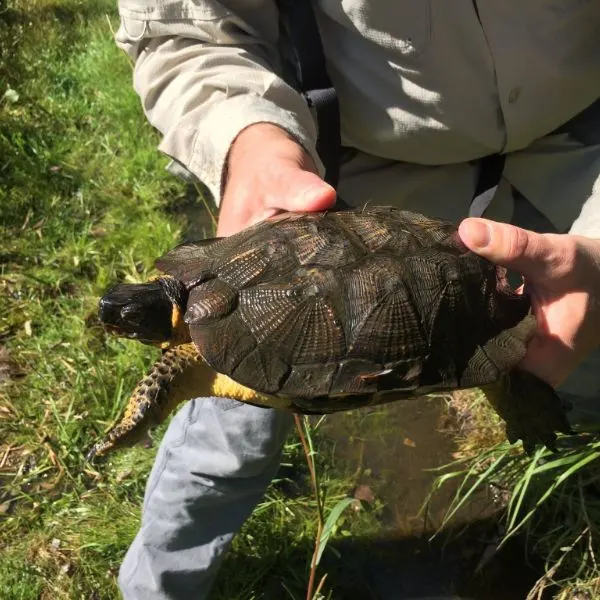
- Experience Level: Intermediate
- Family: Emydidae
- Scientific Name: Glyptemys insculpta
- Other Names: N/A
- Adult Size: 5.5 to 9 inches
- Life Span: 40 to 60 years
- Average Price Range: $250 to $500
- Conservation Status: Endangered
Wood turtles are Endangered turtles that have been seen all across New York. They are semi-terrestrial turtles with very distinctive appearances. They are called Wood turtles because their carapace resembles a carved piece of wood.
It has pyramidal scutes with deep furrows and ridges that resemble polished woodgrain. The upper shell is various shades of golden brown. Their scales and skin are also brownish, but the limbs may have an orange-red hue on the undersides.
Wood turtles are quite intelligent. They have been able to navigate mazes with relative ease, and they know how to trick worms into coming to the surface.
The Wood turtle will stamp the ground with their feet and shell to mimic falling rain. The worms, thinking a rainshower is coming, will emerge from their holes. Out and exposed to the dry air, the Wood turtle happily feasts on them.
Their preferred habitat is a wooded forest with shallow waters nearby such as streams and ponds. While these turtles do roam on the land, they always return to the water. They are omnivores that feed on mushrooms, berries, plants, snails and slugs, worms, caterpillars, and aquatic invertebrates.
Cooter Turtles in New York
13. Northern Red-bellied Cooter
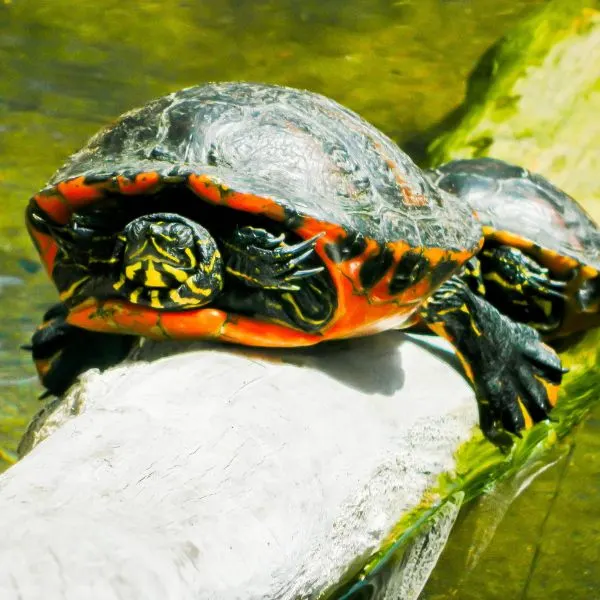
- Experience Level: Beginner to Intermediate
- Family: Emydidae
- Scientific Name: Pseudemys rubriventris
- Other Names: American red-bellied turtle
- Adult Size: Between 8 and 12 inches
- Life Span: Between 40 and 55 years
- Average Price Range: Between $30 and $170
- Conservation Status: Near threatened
Northern Red-bellied Cooters are not native to New York but have been reported in a few central counties and around the Big Apple. They like to live in rivers, ponds, and other similar slow-moving waters.
As their name suggests they have red plastrons, but the bottom shell also has a dark, mirrored pattern. Their carapace is green to olive with bright colors when they are young, but can fade to nearly black as they age.
Their skin is dark green to black with pale yellow to white stripes, swirls, spots, and other patterns.
These turtles are omnivores, but their diet changes as they age. Young turtles consume mostly mollusks, insects, and other sources of protein, but adults start to feed on more vegetation, becoming mostly herbivores as they get older.
Pond Sliders in New York
14. Red Eared Slider
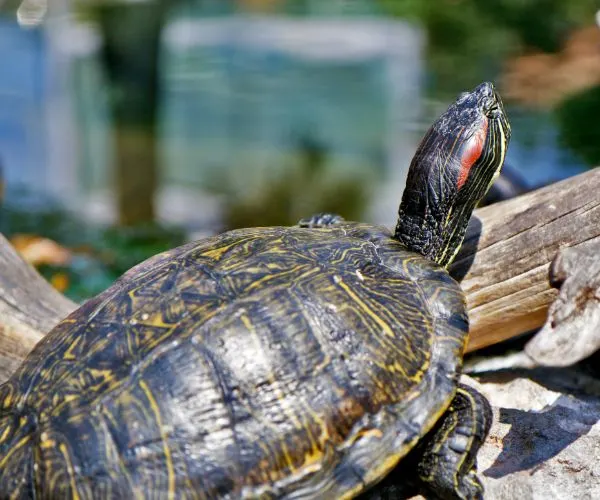
- Experience level: Beginner
- Family: Emydidae
- Scientific Name: Trachemys scripta elegans
- Common Name: Pond slider, Red-eared terrapin, Water slider
- Average Adult Size: 6 – 8 inches
- Life Span: 20 to 40 years
- Average Price Range: approximately $30 to $100
- Conservation Status: Least concern
Red Eared Sliders are an invasive species. Invasive means a non-native species that does harm to the environment or other species. Red Eared Sliders breed quickly, eat nearly anything, and are aggressive toward native turtles.
Once they escape or get released into the wild, Red Eared Sliders quickly establish a colony, such as they have in Central Park and other public spaces in New York, and they take over.
You can recognize these turtles by their slightly ridged shells. The carapace is green to dark brown with yellows, oranges, reds, and browns swirling all over.
The plastron is pale yellow with a few black smudges, and their skin is dark with yellow stripes. They have a pair of oval red patches just behind their eyes that appear to be ears.
Though they are excellent swimmers, Red Eared Sliders prefer slow waters with little to no currents such as lakes, ponds, oxbows, and slow rivers.
15. Yellow Belly Slider

- Experience level: Beginner
- Family: Emydidae
- Scientific Name: Trachemys scripta scripta
- Other Names: Pond slider, Yellow slider
- Average Adult Size: 5 – 13 inches
- Life Span: 50 to 100 years
- Average Price Range: approximately $30 to $130
- Conservation Status: Least concern
Another non-native turtle that has only been sighted around New York City and Long Island, the Yellow Belly Slider is very similar in appearance to the aforementioned Red Eared Slider.
These turtles do get slightly larger though and have a brighter yellow plastron. They also have thick, yellow stripes on their skin, under their jaw, and have wide swaths of yellow behind their eyes.
Yellow Belly Sliders live in rivers, lakes, and wetlands, and love to bask on logs, outcroppings, and banks. These turtles feed mainly on protein sources when they are young, and transition to more vegetation as they age.
Sea Turtles in New York
There are also five species of Sea turtles that can be spotted in the waters off the coastlines of New York. All of these species are Endangered or Critically Endangered and cannot be kept as pets under any circumstances.
These turtles are amazing sites to behold if you’re lucky enough to see them, but please don’t disturb them. They are very skittish and will run away—albeit very slowly—if they are approached while trying to find a proper nesting site.
16. Green Sea Turtle

- Experience level: N/A, Illegal to own any sea turtle
- Family: Cheloniidae
- Scientific Name: Chelonia mydas
- Other Names: Green Sea Turtle
- Average Adult Size: 3 – 4 feet
- Life Span: 50 – 70 years
- Average Price Range: N/A
- Conservation Status: Endangered
Green Sea turtles nest in Hawaii, Florida, the U.S. Pacific islands, and other temperate, tropical locales. Occasionally they can be seen in the shallows off New York. Here they visit the reefs where they feed on sea grasses and algae.
This diet is what gives this turtle its name. When sea turtles were hunted for food, hunters noticed the fat, and connective tissue was green, which came from their diet.
Green Sea Turtles have ornate shells with colors of green, black, brown, orange, and white. Their scales are typically brown to black and outlined in white or pale yellow.
17. Hawksbill Sea Turtle

- Experience level: N/A, Illegal to own any sea turtle
- Family: Cheloniidae
- Scientific Name: Eretmochelys imbricata
- Other Names: Hawksbill
- Average Adult Size: 30 – 36 inches
- Life Span: 50 – 60 years
- Average Price Range: N/A
- Conservation Status: Critically endangered
Hawksbill Sea turtles are critically endangered because they are still illegally hunted in foreign countries. Their gorgeous, marbled shells are coveted and harvested to make items such as hair accessories, or other decorative items and sold for huge profits.
Some people do consume the meat, but it can be mildly toxic because of their diet of sponges. Many sponges contain poisonous toxins that are concentrated in the turtle’s organs.
The Hawksbill turtle is relatively small, only reaching 2 to 3 feet in length, and they have a sharp, hawk-like beak that is great for snipping off pieces of sea sponges.
These turtles nest in tropical waters around Puerto Rico, St. Croix Island, and Florida.
18. Kemp’s Ridley Sea Turtle

- Experience level: N/A, Illegal to own any sea turtle
- Family: Cheloniidae
- Scientific Name: Lepidochelys kempii
- Other Names: Atlantic Ridley, Tortuga Lora (Mexico)
- Average Adult Size: 24 – 27 inches
- Life Span: 30 years
- Average Price Range: N/A
- Conservation Status: Critically endangered
The Kemp’s Ridley Sea turtle is the smallest and most critically endangered Sea turtle. It’s estimated that there are only 7,000 to 9,000 nesting females left.
These turtles stay in the Atlantic Ocean and the Gulf of Mexico. They congregate together and nest in huge groups all at the same time, and during the day, this turtle and the Olive Ridley are the only species known to follow this mass nesting.
Aside from being the smallest, you can also identify these turtles by the serrated ridge along the back, and their greyish green coloration. Their underside is white or cream colored.
Kemp’s Ridley Sea turtles feed on crabs, mollusks, jellyfish, and crustaceans.
19. Leatherback Turtle

- Experience level: N/A, Illegal to own any sea turtle
- Family: Dermochelyidae
- Scientific Name: Dermochelys coriacea
- Other Names: Atlantic Leatherback, Leatherback
- Average Adult Size: 4 – 8 ft
- Life Span: 30 – 50 years
- Average Price Range: N/A
- Conservation Status: Endangered
The Leatherback Sea turtle is the overachiever of Sea turtles. They are the biggest turtle in the world, they don’t have a hard shell, they dive deeper than any other species, can withstand the coldest waters, and take on the longest migrations. Whatever they do, the Leatherback Sea turtle does it better than other species.
These turtles spend most of their lives in the open ocean, and seeing them off the coast is a rare treat. Leatherback turtles nest in the West Indies, Africa, Trinidad, and Tobago.
Leatherback Sea turtles help keep jellyfish populations in check by feeding on hundreds of them a day. They mainly feed on giant lion’s mane jellyfish, often eating 300 to 500 a day. They also feed on sea squirts, occasionally fish and squid, and floating seaweed.
20. Loggerhead Sea Turtle

- Experience Level: N/A, Illegal to own any sea turtle
- Family: Cheloniidae
- Scientific Name: Caretta Caretta
- Other Names: Loggerhead
- Adult Size: 2.5 – 3.5 feet
- Life Span: 70 – 80 years
- Average Price Range: N/A
- Conservation Status: Endangered
Loggerhead Sea turtles have somewhat heart shaped shells, and wide heads relative to their bodies. These heads house extremely strong jaws that can crack thick conch, and whelk shells. They also feed on horseshoe crabs, lobsters, and other crustaceans.
These Sea turtles are the most abundant species, but they are still considered endangered and protected federally.
Loggerhead Sea turtles nest on both sides of the Atlantic Ocean, in the Mediterranean Ocean, along Japan’s coast, and in other areas along Africa.
FAQs
Do Sea turtles nest on New York’s shores?
While some Sea turtles occasionally visit the Empire State, there are no reports of any species nesting on the state’s beaches.
Wrapping up
Well, that wraps up our list of the 20 types of turtles in New York state. We’ve covered the 12 native species, three non-native turtles, and five types of Sea turtles that can be spotted from New York’s beaches.
This list is best used as a field herping guide but can be used to help you decide on a pet turtle if you are so inclined. Whenever you can, try to adopt a turtle from a shelter or reptile rescue. When that’s not possible, seek out reputable, licensed breeders.
Captive bred turtles live longer and have fewer health problems than captured wild turtles.
If you enjoyed this list, feel free to comment down below and discuss the turtles of New York with your fellow herping enthusiasts!
Other nearby states
